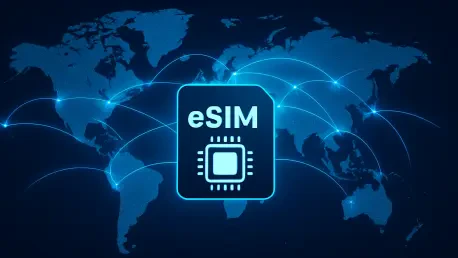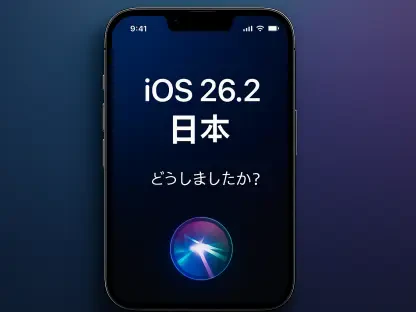Imagine a world where crossing international borders doesn’t mean wrestling with tiny SIM cards or bracing for a surprise phone bill that could rival the cost of your entire trip. Embedded SIM technology, commonly known as eSIM, is turning this vision into reality by replacing physical cards with a software-based solution that simplifies mobile connectivity. For travelers, remote workers, and digital nomads, this innovation offers the ability to activate or switch network plans with just a few taps on a smartphone or device, eliminating the frustrations of traditional methods. The rise of eSIMs addresses long-standing issues like inconvenient swaps, spotty coverage in foreign lands, and the dreaded “bill shock” from unexpected roaming charges. Beyond mere convenience, this technology promises cost transparency, enhanced security, and applicability far beyond personal use. As eSIMs gain traction, they are poised to redefine how global connectivity operates, paving the way for a more seamless, user-centric mobile experience.
Understanding the eSIM Revolution
Breaking Down the Basics
The shift to eSIM technology marks a significant departure from the physical SIM cards that have long been a staple of mobile communication. Unlike their predecessors, eSIMs are built directly into devices, enabling users to download and manage carrier plans digitally without ever needing to handle a physical card. This eliminates the fumbling with tiny trays or the risk of losing a SIM during travel. More importantly, eSIMs allow for pre-configured plans that can be set up before departure, ensuring connectivity the moment a user lands in a new country. The frustration of hunting for a local SIM at an airport kiosk becomes a thing of the past, replaced by a streamlined process that prioritizes ease. This fundamental change not only saves time but also reduces the stress associated with staying connected abroad, making it a vital tool for anyone navigating multiple regions or working remotely across borders.
Another key aspect of eSIMs lies in their ability to store multiple profiles on a single device, offering unparalleled flexibility for users who frequently switch between networks. Imagine a business traveler moving between countries, toggling between a home carrier and a local plan to optimize costs and coverage with minimal effort. This multi-profile functionality means there’s no need to juggle several SIM cards or devices, as everything can be managed through software settings. Additionally, the digital nature of eSIMs aligns with modern sustainability goals by reducing plastic waste associated with traditional cards. The technology’s design caters to a hyper-connected world where adaptability is crucial, ensuring that users remain reachable and productive regardless of location. As more devices adopt this standard, the potential for seamless integration across personal and professional spheres continues to grow, highlighting why eSIMs are seen as a cornerstone of future mobile infrastructure.
Cost and Security Advantages
One of the most compelling reasons for the growing popularity of eSIMs is the financial clarity they bring to international mobile usage. Traditional roaming charges have long been a source of anxiety, with many users returning from trips to face exorbitant bills due to hidden fees or unclear pricing structures. eSIMs counter this by allowing individuals to select transparent plans tailored to specific needs, often before even leaving home. This means no more surprises—just predictable costs that can be budgeted in advance. For frequent travelers or remote professionals, this level of control over expenses is invaluable, transforming how they approach connectivity. The ability to compare and activate plans digitally also empowers users to seek out the most cost-effective options, ensuring they aren’t locked into overpriced or unnecessary services while abroad.
Security represents another critical area where eSIMs outshine traditional alternatives, offering robust protections in an era of increasing digital threats. Physical SIM cards are vulnerable to fraud, such as SIM swapping, where malicious actors can gain unauthorized access to a user’s phone number and sensitive data. eSIMs mitigate this risk through advanced encryption and by binding profiles directly to a specific device, making unauthorized access significantly harder. This is especially beneficial for business travelers or anyone handling confidential information on the go, as it adds a layer of defense against potential breaches. Furthermore, the inability to physically remove or tamper with an eSIM enhances its reliability as a secure connectivity solution. As cyber risks continue to evolve, the emphasis on fortified security within eSIM technology positions it as a safer choice for users prioritizing data protection across international networks.
Industry Shifts and Broader Impacts
Device Integration and Carrier Expansion
The momentum behind eSIM adoption is evident in the proactive steps taken by major technology companies to integrate this feature into their products. Leading smartphone manufacturers, such as Apple and Samsung, have increasingly prioritized eSIM support, with some newer models phasing out physical SIM trays entirely in favor of a fully digital approach. This shift isn’t limited to phones—laptops, smartwatches, and even tablets are joining the trend, reflecting a broader move toward universal compatibility. Such integration signals a commitment to making eSIM the standard for future devices, ensuring that users have access to seamless connectivity regardless of the hardware they use. As more flagship products adopt this technology, it becomes clear that the industry views eSIMs as a critical component of modern mobile ecosystems, driving innovation and user satisfaction to new heights.
Telecom carriers are also playing a pivotal role in accelerating the eSIM wave by expanding their infrastructure to support remote activation and multi-country plans. Across regions like Europe, Asia, and Australia, providers are rolling out systems that allow users to download and switch plans without relying on costly third-party roaming packages. This development is particularly significant for international travelers who can now access local rates and coverage with ease, bypassing the traditional barriers of cross-border connectivity. Carriers are investing heavily in interoperable solutions to ensure that eSIM users experience minimal disruption, even in areas with varying network standards. While the global rollout isn’t uniform, the concerted effort by telecom giants to prioritize eSIM-friendly services underscores a shared vision of a more connected world, where geographic boundaries pose less of a challenge to staying online.
Regulatory Support and Market Challenges
Governments and regulatory bodies worldwide are recognizing the potential of eSIM technology to transform mobile connectivity, often stepping in to facilitate its adoption through supportive policies. By promoting competitive pricing frameworks and encouraging interoperable roaming agreements, these entities aim to make eSIM plans more affordable and accessible to a broader audience. Such initiatives are crucial for ensuring that users benefit from fair costs and reliable service, regardless of where they travel. Additionally, regulatory encouragement helps standardize protocols across regions, reducing fragmentation that could otherwise hinder the technology’s effectiveness. This governmental backing is a key driver in smoothing the path for eSIM integration, fostering an environment where both consumers and businesses can embrace the advantages of digital connectivity without undue obstacles.
Despite this progress, the journey toward universal eSIM adoption isn’t without hurdles, particularly in terms of market disparities and infrastructure readiness. Some regions lag behind due to outdated telecom systems or limited investment in the necessary technology, creating an uneven global landscape. This disparity means that while users in developed markets might enjoy seamless eSIM functionality, others may still struggle with compatibility or access to supporting carriers. Addressing these gaps requires coordinated efforts between governments, carriers, and tech providers to upgrade infrastructure and expand coverage. Moreover, the varying pace of adoption highlights the need for strategic planning to ensure that no market is left behind. Overcoming these challenges is essential for realizing the full scope of eSIM potential, ensuring that its benefits reach users across diverse economic and geographic contexts.
Looking Ahead: Barriers and Possibilities
Educating Users for Wider Acceptance
A significant barrier to the widespread embrace of eSIM technology lies in user familiarity and trust, as many still cling to physical SIM cards due to habit or skepticism about digital alternatives. The concept of managing connectivity through software can feel abstract or unreliable to those accustomed to tangible solutions, creating hesitation even among tech-savvy individuals. To counter this, targeted education campaigns are needed to demystify eSIMs, explaining their ease of use and reliability in clear, relatable terms. Highlighting real-world scenarios—such as activating a plan mid-flight or switching carriers without a store visit—can help bridge the knowledge gap. By addressing these concerns head-on, the industry can build confidence in eSIMs as a dependable option, encouraging more users to transition from traditional methods to this innovative approach.
Beyond initial education, ongoing support and accessible resources play a vital role in sustaining user adoption of eSIM technology over time. Many potential users may worry about troubleshooting issues or navigating complex settings without the physical reassurance of a SIM card. Carriers and device manufacturers must prioritize user-friendly interfaces and robust customer service to alleviate these concerns, ensuring that help is readily available when needed. Additionally, showcasing testimonials or case studies of successful eSIM usage can reinforce trust, demonstrating how the technology performs under various conditions. This focus on continuous engagement helps normalize eSIMs as a standard feature of modern devices, reducing resistance and fostering a cultural shift toward digital connectivity. As awareness grows, so too will the acceptance of eSIMs as an integral part of the mobile experience.
Expanding Horizons with IoT and Beyond
The influence of eSIM technology extends far beyond smartphones, opening up transformative possibilities in the realm of the Internet of Things (IoT) and connected devices. From agricultural sensors monitoring crop conditions to logistics trackers ensuring real-time shipment updates, eSIMs enable a vast network of devices to maintain constant connectivity without the constraints of physical SIMs. This adaptability is crucial for industries seeking to optimize operations across global supply chains, where reliable data transmission can make or break efficiency. By embedding eSIMs into a diverse array of equipment, businesses gain the flexibility to manage fleets or monitor remote assets with unprecedented ease, marking a significant leap forward in industrial innovation and automation.
Looking further, the potential applications of eSIMs in emerging fields signal a future where connectivity underpins nearly every aspect of daily life and enterprise. Environmental monitoring systems, for instance, can leverage eSIMs to transmit critical data from remote locations, aiding in climate research or disaster prevention efforts without the need for manual SIM swaps. Similarly, smart cities stand to benefit as eSIM-enabled infrastructure—think traffic sensors or public safety networks—creates more responsive urban environments. The scalability of this technology ensures that as new use cases arise, eSIMs can adapt to meet evolving demands. This broad applicability underscores the role of eSIMs as a foundational element in a hyper-connected era, driving progress across personal, commercial, and societal spheres with lasting impact.
Reflecting on a Connected Legacy
Looking back, the journey of eSIM technology unfolded as a remarkable response to the persistent challenges of global mobile connectivity, addressing pain points that once seemed insurmountable. The elimination of physical SIM swaps, the curbing of unpredictable roaming fees, and the bolstering of security through encrypted profiles reshaped how users approached staying online across borders. Industry giants and telecom carriers rallied behind this innovation, embedding support into devices and networks with a vision of seamless access. Even as hurdles like user hesitancy and regional disparities tested the pace of adoption, the steady alignment of regulatory frameworks and technological advancements cemented eSIMs as a pivotal force. Moving forward, the focus should shift to actionable steps—enhancing user education, upgrading lagging infrastructures, and exploring untapped IoT applications. By prioritizing these areas, stakeholders can ensure that the legacy of eSIMs continues to evolve, delivering ever-greater connectivity solutions for a world that demands nothing less.









